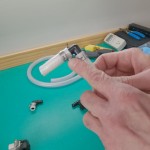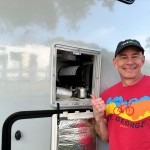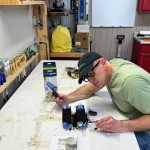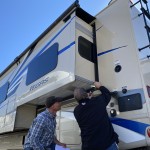This post may contain affiliate links.
If you’ve followed our blog for a while, you know by now that we’re rolling with a 420 Amp Hour Lithium battery in our motorhome. Maybe I’ve even mentioned that the battery is from Lithionics. Well, we’re 6 months or more in with that battery now, and it shows no signs of slowing down. In fact, we’re at a serviced campground right now, and I HAVEN’T EVEN BOTHERED TO HOOK UP THE ELECTRICITY. Our battery is so solid that most days, even pulling out the electrical cord is more trouble than it’s worth.
So when we were in Tampa recently for the Florida RV SuperShow, we couldn’t resist the urge to drive across the bay, eat some seafood by the water, and head over to Lithionics’ facility in Clearwater. There, we met CEO Stephen Tartaglia, and he took us on a tour. Have a look:
The one thing that really came through for me on this trip was the attention to testing. For example, each battery that goes out – and I mean every one – is subjected to load testing. And while it’s being tested, they take FLIR images of the battery to find any anomalies or hot spots in the assembly. They save all of their results and images and can tell you – even six years later – how much of the original capacity you still have, and how their battery is holding up.
The BMS is something else that’s pretty interesting. All of the individual cells in the battery have to report in to the BMS every second, or the battery shuts down. The BMS itself communicates over optical cabling (because optical cables are immune to magnetic and RF interference). Pretty neat.
Another thing that came up is the safety of the batteries and the particular chemistry they use (LiFePO4). Lithionics batteries are the only ones I know of that are cleared to ship by air. Think about that one for a minute…
Anyway, now that I’ve visited the battery mother-ship, there’s a lot more I could tell you about their batteries. But for now, let’s just say I’m pretty happy with ours.
Cheers!











James, Stephen, & Stef,
Thanks for this great video. Very informative. I did not know how complex these batteries are, or how robustly built. I would love to know more… especially what peripherals are needed, what type of inverters we can use with Lithium/ Lithionics products and anything else that is specific to this battery install. Its frustrating not to know all the functional details of an install.
Thanks again for a very useful video! Great job on camera work Stef!!
James,
Lithionics
has only 2 items? batteries and bms?
Xantrex
has The Freedom e-GEN System: the following core components:
• Freedom SW 3012 Inverter/Charger
• Lithium-ion Battery Module and Battery Management System (BMS)
• Second alternator and associated regulator
• Conext ComBox for Freedom SW
Advanced RV
has a Second alternator with a custom engineered dynamic torque converter,
“an oad pulley is better than solid pulley -Advanced RV
What voltage is the most efficient 12, 24 or 48 ? for my RV ?
the arv alternator is talked about with good quality and twice the price.
I think that on this thread was a mention about a Delco-Remy alternator.
Advanced RV
has the Second alternator with a custom engineered dynamic torque converter,
“an oad pulley is better than solid pulley -Advanced RV
https://youtu.be/XANYxoEF_HY
I think that Advanced-RV alternator you’re referring to was a 12 volt alternator. The Volta system they use now has a physically smaller 50 volt alternator.
Hi i need you to call me if possible. I just upgraded my electrical system on 78 dodge sportsman RV with 8900 series, now I need solar power srong enough for the RV to self sufficient without plugging in, I have a home solar 1800 I wonder if I can use it once I find out how many panels I need also batteries,I would appreciate ur experience call
Hi Juan!
We don’t sell products here at the Fit RV. You should probably consult an RV electrical specialist in your area for a detailed consultation.
As they are a battery manufacturer, Lithionics does make just the batteries and BMS in this system.
There’s probably a big philosophical debate about what voltage is most efficient. I’ll jist say they both work.
Greetings James. I’d like to make an LTV Wonder generator free, and have this Lithium battery/alternator system put on my rig. Is this possible, and, how much might it run me – ballpark? Thank you.
Well, it’s absolutely possible. But I can’t really give you an idea on price. The batteries themselves can run into the thousands, depending on capacity.
As I don’t sell or install the systems myself, I’m not really in a good position to give you a price.
When this is offered from manufacturers, for example, the option generally runs in the $20,000 range.
Thank you James. Do you know of an installer? Does Lithionics?
I think Lithionics might be able to refer you.
You could always try a marine electrician, if there are any near to you. They should have a good handle on these kinds of things.
I’ve had work done at AM Solar – if you’re anywhere near Oregon.
Thanks for this very informative thread.I’m seeking a company to work with to provide energy battery bank and power for a bus conversion prototype unit. Will this unit installed at your location eliminate the need for any generator powered by fossil fuels? I need to be able to run typical loads run all by electric power: 50 gallon hw heater, 2 water pumps, point source electric water heater, 2 burner stove top, small potable oven/toaster, energy smart fridge, led lighting, low voltage electric floor heat system, energy star flat screen tv. and kitchen/bath fans.I would like to use 800 kw of solar panels and also have the battery bank charge by driving the bus.Can you do that?thanks!
Well, first off, yes, our install does eliminate the need for a generator.
But most RV applications only have (at most) a 13 gallon water heater. Heating 50 gallons of hot water on electricity would be prohibitively expensive to do from a battery. So it sounds like you have a unique situation. Or perhaps you need to consider using propane as well.
Lithionics only sells batteries. They may be able to refer you to an RV or Marine specialty shop that could quote you out something.
We here at The Fit RV do not do any conversion or modification work (except on our own rig).
Heating water is easy with the heat from the chassis (or vehicle) engine.
There is info on this setup on a few rv sites regarding diesel-powered
vehicles and hot water.
We all drive “internal combustion engine” vehicles that are water-cooled,
( except electric cars, most motorcycles etc, ) and these engines MAKE HOT WATER.
I have an RV with a small 4 cylinder gasoline engine that uses the engine made hot water to heat the coach hot water all year ’round and the coach inside air in the winter, while you drive or are parked and temporarily idle the engine.
There is a heat exchanger device that transfers the heat only, from the hot water to air &/or water.
THIS has piqued my interest! I hope to eventually dump my 4 Discovery 12v AGMs for a system like this. Caution: nerd-out time!
You won’t regret it. Just watch the temperatures!
On a different note I have a different type of battery question for you. We have a 40′ Fleetwood LE DP, we have 4 AGM batteries connected to our inverter and 3 solar panels up top. We are looking to replace the batteries and have been checking into carbon foam batteries, I thought though some research they looked interesting. Something new in the RV market, I was told they are used in the boating market with a good success rate. Have you heard anything about them? http://www.fireflyenergy.com is there website. Thanks for any and all info you might have. Kathy
Sounds interesting, but I don’t have any personal experience of knowledge of those batteries.
Reading the site, it sounds like a different rendition of basic lead-acid chemistry, just pasted(?) onto a different medium.
The good thing about those, I suppose, is that since they are lead-acid batteries you can probably get by without changing or reprogramming all of your charging sources (alternator, converter, solar, etc.). That would save yo some money. Don’t know if their lifetime cycles are realistic or not. If you get them, I’d be interested to hear your experience after a year!
Just viewed your black tank test and with the Travato’s built in black tank flush, doesn’t that perform the same function as that device you used and make the effort redundant?
Our Travato doesn’t actually have a black tank flush. (But then again, we don’t really have a black tank…)
But if your rig DOES have a black tank flush, then yes, I would recommend saving the money, not buying any other gadgets, and using the built in flush system.
Do these batteries charge off solar safely?
In my research of modernizing my 1997 Rialta, I came across a fuel cell video known as the Bloombox, which is a fuel cell that came out in 2012, and runs off any kind of gas, and I believe hydrogen
( not sure on the Hydrogen I need to revisit the video). My question is, has lithionics seen this technology, and have they considered the use of this technology with their battery banks? Or have they looked into the availibility of this system for RV owners?
Yes, our batteries absolutely do charge safely from our 300 watts of solar.
It is important that you have a solar charge controller that will properly charge the lithium batteries – at the proper voltages, etc.
Most lower priced solar charge controllers probably do not have a setting for lithium, so I’d say it is important to get a charge controller that is programmable.
Sort of the same problem with the inverters that another commenter mentioned.
If your charge controller can’t be made to charge the lithium batteries properly, you risk damaging or not fully charging the lithium battery.
According to Roadtrek their lithium battery is equal to 2 1/2 golf cart 6 volt batteries. Is that what you’re finding?
I don’t know the specs of the Roadtrek batteries offhand.
But two 6 volt golf cart batteries would give you about 220 amp-hours of capacity. And of that, you should only use half, so say 110 amp-hours.
I find with my battery, I actually have MORE than the rated 420 amp-hours of capacity.
So, I’d say that in terms of usable capacity, our battery is equal to four pairs of golf cart batteries.
The latest video about lithium batteries created some concerns for me. Do I understand that 50,000 data points are being monitored constantly and if one malfunctions, the system shuts down? Doesn’t sound like a reliable source of power to me…why can’t the system “work around” the weak link and soldier on? Also, did I hear that most (or all) of the currently available inverters are not a good match for lithium batteries? We have to wait for inverter technology to catch up? So what is happening now with lithium battery + inverter systems if they aren’t really made for each other?
Let’s see if I can put your mind at ease.
50,000 data points aren’t checked every second. Those 50,000 data points are what they collect on each battery at Lithionics before they ship anything out.
On a second-by-second basis, what happens is each cell in the battery checks in with the BMS. And it’s actually VERY reliable. In six months, we’ve had not a single hiccup from the battery.
The main things the BMS is checking for are thermal runaway, and over or under voltage. These are “I’m about to catch fire” or “I’m about to be damaged by excessive discharge” kinds of events. And in those cases, yes, you absolutely DO want the battery shutting itself down, because something is really wrong.
As far as the inverters: If your inverter allows you to program charging currents and voltages in a way that corresponds with what the lithium battery wants to see, then there’s no problem in using it. However, if your inverter/charger only offers fixed profiles for “Wet Cell” and “AGM”, then it won’t properly charge your lithium battery. Some inverters are more easily programmed than others. Better ones, like our Xantrex, will be easily programmable, or offer an appropriate setting for Lithium. That’s the main concern there.
Dear David (and James)
Each one second, we collect 5 readings on the entire battery assembly. Every single cell inside must report “good health” every one second…so, if a cell fails or the electronics themselves fail, the longest our battery can be “live” or “hot” is one second…..the best safety feature in the industry. Now, rest at-ease….less than 1/10 of 1 percent of all the batteries we ship yearly have a fault code issued…..that means our annual quality control record is 99.9%….failures are super-rare, and if they happen, they are normally caused by incorrectly programmed chargers. Sincerely, Stephen Tartaglia, Director of Engineering, Lithionics Battery
Wow! This is very interesting stuff. This video partially explains the high cost and the reason I cannot go buy one at retail level. I never knew that Inverters had to be programmed for Lithium batteries as well. Please do state which inverters will work with your batteries and have a list of folks who do the install on your website. We need more information on the basic requirements for an install of these batteries. I know Humble Road is one such installer, and probably Advanced RV as well. You can always trust James to do a great job of any install – such an analytical and perfectionist mindset.
Stephen, thanks for showing us your facility and explaining how these batteries work. They are the gold standard today.
Great video! Just one question: why do I distinctly see Stefany’s bored face and eye roll in my mind?
She was actually holding the camera on this one. Perhaps you’re getting those vibes through the video! lol.